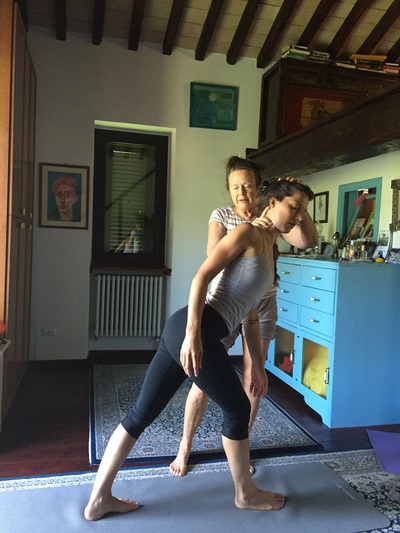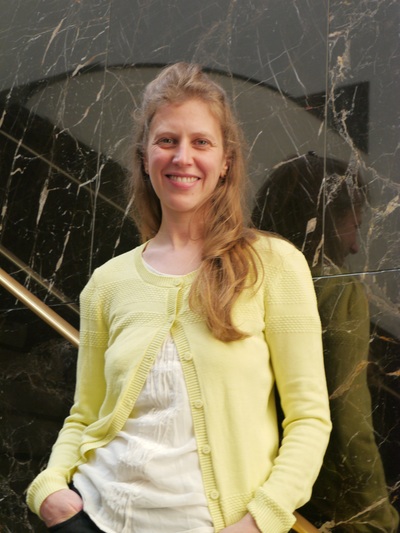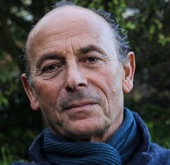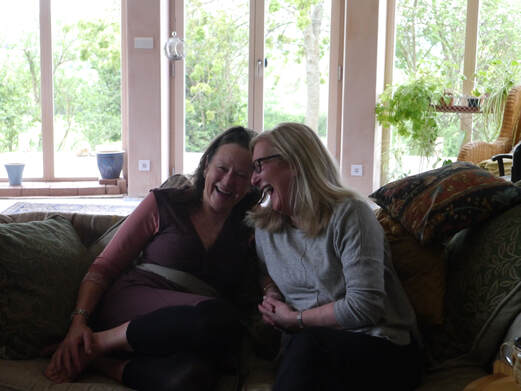
As a journalist and a yoga teacher, it is a joy when these interests can be combined. Talking yoga, sharing experiences (and a few laughs) with these inspirational teachers, was an informative and rewarding project. Inevitably, yoga does not always offer these opportunities - classes, workshops and training can often be more about listening and absorbing the knowledge and wisdom of our teachers. The following interviews give a small insight into three teachers who kindly gave up their time to chat about their own yoga journey.
Diane Long and Wendy Jacob
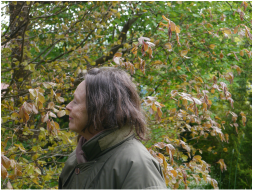 Diane Long
Diane Long
Yoga is a journey in many ways – a personal journey that challenges, supports and accompanies you throughout your life. A lifetime of learning and discovery, influenced by teachers who share their wisdom and experience, guiding you along the many paths that yoga offers. Wendy Jacob has been talking to some of today’s leading teachers about their own yoga journey, influences and commitment to yoga.
Diane Long - Scaravelli
Diane Long is in the UK staying with friends in their idyllic, newly constructed cottage outside Bath. Injury has encouraged her to cut back on some of her teaching, although there is little sign of any lasting damage. She moves with grace and poetic ease, offering a warm welcome and sparking an inner connection as she communicates her deep felt and enduring commitment to Vanda Scaravelli who has influenced her life and teaching.
She is best known for teaching Intuitive Yoga, following 23 years as a devoted student of Vanda Scaravelli. Born in North Carolina, Diane moved to Italy in the early 1970s where she met Vanda, who invited her to become her student. Diane began teaching in the late 70's in Italy and later in Canada, England and the United States.
Diane rarely uses the word ‘yoga’, but describes the depth and fluidity of movement as being a personal experience: “It is about knowledge of our own body and personal expression. There is a need to search – exploration without ambition – which never stops.”
Diane was 29 and Vanda 68 when they met. Diane was athletic – Iyengar and Tai Chi challenging a naturally strong and flexible body. A chance meeting, when Vanda noticed her at a class and an invitation to lunch initiating a lifetime of commitment: “When I saw her move, I knew what I was looking for,” Diane recalls. She explains that other influences in body movement had not offered the ‘riches’ of what she describes as the Scaravelli ‘approach’. “It is not a system or definable. It allows you to free places within yourself and wake up and address these. When I met Vanda, I could ‘do’. I had to find something different in myself which allowed me to transform within these postures.”
Diane is humble about her own teaching, explaining that when Vanda encouraged her to teach in London, instead of her, she did not feel ready. “I am a slow learner”, she explains.” I loved the teaching, but felt the responsibility and wanted to learn more.” And the learning continued, with Diane seeing Vanda two or three times a week and gaining to trust in her own ability. “Vanda was I her 80s and I realised she wouldn’t live forever. You are really lucky if you find something rich and profound on this mysterious journey of life – it is also about our own ability to find something.”
“You must teach everywhere”, said Vanda (not so easy with two small children to care for and coping with divorce). But Diane carried on: “I went wherever anyone asked me, amazed that people were paying me for this!” Since then she has travelled the world and despite cutting back, her diary looks full and those that she has taught and influenced ensure that Vanda’s work continues to attract and inspire further generations looking for depth and inner connection through movement.
Vanda Scaravelli died in Italy in l999 at the age of 9l. Her book Awakening the Spine shows her in her 80s performing poses that demonstrate her amazing flexibility and strength. Diane’s teaching carries on this work, exploring the body, encouraging integration and release, evolvement and access to deeper levels of connection.
Although she says she is slowing down, she is spending six months at her home in Rome this summer, where she will teach small groups. “You need to use your energy wisely,” she counsels. “My energy and time of life has allowed me to sow a lot of seeds. I am here to help anyone who wants to go deeper who arrives at my door.”
Although Diane has been reluctant to put into words the essence of this work, she has been persuaded and will be publishing a book later this year.
www.dianelongyoga.com
Olivia Crooks - Dynamic Yoga
Meeting Olivia Crooks in London and you are struck by how youthful and fragile she appears, compared to the strength and authority she displays in videos of her practice with Godfrey Deveraux.
Contrast is not unusual in yoga and this superficial observation is tempered by time, as you realise that she is a highly articulate and deeply serious yoga practitioner and teacher trainer in the Dynamic Yoga Training Method - a unique approach to yoga which emphasises what you can feel and the nature, needs, capabilities and intelligence of the body.
But it has taken Olivia some time, commitment and a certain amount of good fortune to fill this space. Although she is now living in the Brecon Beacons, Wales, she says she spends much of her time in the air, travelling to workshops and events in Europe. Perhaps, best known for her work with Godfrey, their Windfire Yoga Retreats (which are now in their 18th year) and the Windfire Yoga Teacher Training Teacher, she says she is content with where she is now.
Now in demand for her clarity and sensitivity in teaching, it has taken her some time and a yearning for discovery to reach this place. Her first introduction to yoga was at 16, in Hitchin in the UK, followed a few years later by classes in a gym in Australia. She trained with Simon Borg-Olivier in Australia and also completed a year long training course which helped her deepen her practice, but she says, at that time she had no intention to teach. She did however accept an invitation to teach in a women’s refuge and discovered there was more to yoga teaching: “These women were so fragile, that all you could do was breath work,” she explains. This led her to ask: “ Is yoga about what you can do, or what you feel.” Her enquiry continued when she met a man who was bringing spirituality to men on parole and she was invited to help.
Then followed more enquiry and development – working, attending workshops, but still searching: “I had a sense of this is not ‘it’, but I didn’t know what ‘it’ was!. I went to India for two months, came back via England and attended a workshop with Godfrey Deveraux in Bethnal Green, London.” Olivia had found ‘it’. “I was lying there waiting for the teacher and heard a voice. There was a deep familiarity – more a frequency than the tone. I had never experienced being in my body so deeply whilst practising, until that day.”
Olivia asked Godfrey to come to Australia, with the promise of bringing people to his workshops. Godfrey initially resisted, but changed his mind three days later and arrived in Australia six months later. This was to lead to the union that has endured to this day. “Before I was telling people how to get into shapes and reminding them about their mind and breath. This was a more intelligent way to practice – recognition that we are honouring, opening and harnessing this intelligence. ”
Godfrey returned to Europe and Olivia joined him two weeks later. Olivia became his apprentice as they travelled together to Turkey, Israel and America.
Dynamic Yoga is unique for each individual. Asked to describe the training method, Olivia says: “It is a step by step methodology, inviting people to uncover the intelligence that they are. We are saying, ‘come this way’ and find this intelligence for yourself” This, she accepts can take a little time and the training course are lengthy and require commitment. “In a lot of subjects of learning, most of the time people wait to be told what to do.”
Dynamic Yoga is a spiritual practice and Olivia says she is deeply appreciative of the learning and the opportunity to teach. Asked about the future, she states that she is content as she is, but in the longer term would like Godfrey’s work to carry on. “For me teaching Dynamic Yoga is being part of a picture being painted, with the subtleties of step by step, progressive instruction. I would like Godfrey’s work to be preserved – his writing and his talks. There is a minority that know about this, as yoga is so big now. It is not a sense that this needs to happen, life will deal with that anyway.”
www.dynamicyoga.com
John Stirk - the Original Body
It is a relief to escape the sticky heat for the cool of the London Unitarian Church where John has arranged to meet. Deeply tanned, he looks more like a rugged mariner than a yoga teacher, explained by his travels and that he now lives by the sea and enjoys the outdoors.
John is best known for his enquiry into the Original Body and his workshops that explore human evolutionary movement. But this is where he is now, a long way from where he started. “When I met my wife I was 30, had back problems, bronchitis and depression,” he explains. (His wife is Lolly Stirk, well-known pregnancy for yoga teacher.) “She had been doing yoga with Iyengar teachers and within three weeks, the change in me was extraordinary - depression lifted and back pain eased.”
This was in the 70s and John continued with the yoga, saying that the feeling when practising ‘seduced’ him. This was a time of exploration, discussion and breaking boundaries and John relished this time, working with people such as psychiatrist and writer R. D. Laing. A time of self discovery that John says felt like coming home.” We spoke about what was going on, and Laing spoke about his time in India. He thought yoga was important as yoga changes patterns at a physiological level.”
John continued to learn: “I didn’t have a teacher – I just did things and learnt that you should not force the body.” He also started to teach stretching and working with the breath, soon realising that it was important on a biomechanical level that he learnt more. This led to a course on osteopathy, which he says, complemented the teaching – the relationship to gravity, the importance of the spine and using the breath. “I practised everyday while I was learning to become an osteopath. I started to became more concerned about how to work on people. This was an education - why such pain and how could I help?
Inspiration and self learning fuelled these years and he lists many influences – B. K. S. Iyengar, Donna Holleman, Vanda Scaravelli, Moshé Feldenkrais, Ida Rolf, Emilie Conrad, J.Krishnamurti – all presenting different ways of looking at ourselves. But, his interest in osteopathy appears to have had as much of a sway on his future work as he discusses the trends in physical movement and osteopathy today, declaring he is not a fascia man. “On the physiological level, its all evolved and functioning together. The long bones connect to the spinal bones through the pelvis and shoulder girdles, integrating the whole system through long bones.” He later expresses a current interest in muscle contraction, as he continues to explore the complexities in anatomy and movement.
Around 2000 he made the decision to leave London, moving to Sussex and giving up his osteotherapy practice to devote his time to teaching. He now teaches in London and Sussex. This, he says has helped him creatively. “ Creativity is an ongoing process and always changing. You can talk about your body, without talking about yourself. It is important to have an interest and ongoing curiosity”.
As well as his regular classes, he travels in the UK and abroad giving workshops. His ‘What Lies Beneath’ workshops are a deepening experience for teachers, inviting them to explore not only what is in themselves, but also how this relates to their teaching. “We see if we can find ways of moving that predate yoga – a way of being and moving. You need a structure to start with, which is the essence of a yoga practice, but in a human body the application of techniques can bring out negative effects.”
He takes the role of teacher seriously: “ It is a courageous thing to take on – a serious responsibility to ourselves and one another. There is the responsibility of living with your discoveries and your relationships. You need to find this in yourself.”
Another area of his work - The Original Body - encourages teachers to look towards the primal body and explore other options: “If you are not trying to arrange the body in a set way, there is a freedom. I am looking at impediments to a deeper understanding.” His book The Original Body will be published later this year, giving greater insight into his work in this area.
Asked to summarise his work, John returns to his background in osteotherapy, stressing the importance of understanding the nature of the spine. But I am sure his students will agree his knowledge and passion takes you to a deeper level of enquiry and integration than any other ‘bone’ man.
www.johnstirk.com
Published in Spectrum - Autumn 2015
Diane Long - Scaravelli
Diane Long is in the UK staying with friends in their idyllic, newly constructed cottage outside Bath. Injury has encouraged her to cut back on some of her teaching, although there is little sign of any lasting damage. She moves with grace and poetic ease, offering a warm welcome and sparking an inner connection as she communicates her deep felt and enduring commitment to Vanda Scaravelli who has influenced her life and teaching.
She is best known for teaching Intuitive Yoga, following 23 years as a devoted student of Vanda Scaravelli. Born in North Carolina, Diane moved to Italy in the early 1970s where she met Vanda, who invited her to become her student. Diane began teaching in the late 70's in Italy and later in Canada, England and the United States.
Diane rarely uses the word ‘yoga’, but describes the depth and fluidity of movement as being a personal experience: “It is about knowledge of our own body and personal expression. There is a need to search – exploration without ambition – which never stops.”
Diane was 29 and Vanda 68 when they met. Diane was athletic – Iyengar and Tai Chi challenging a naturally strong and flexible body. A chance meeting, when Vanda noticed her at a class and an invitation to lunch initiating a lifetime of commitment: “When I saw her move, I knew what I was looking for,” Diane recalls. She explains that other influences in body movement had not offered the ‘riches’ of what she describes as the Scaravelli ‘approach’. “It is not a system or definable. It allows you to free places within yourself and wake up and address these. When I met Vanda, I could ‘do’. I had to find something different in myself which allowed me to transform within these postures.”
Diane is humble about her own teaching, explaining that when Vanda encouraged her to teach in London, instead of her, she did not feel ready. “I am a slow learner”, she explains.” I loved the teaching, but felt the responsibility and wanted to learn more.” And the learning continued, with Diane seeing Vanda two or three times a week and gaining to trust in her own ability. “Vanda was I her 80s and I realised she wouldn’t live forever. You are really lucky if you find something rich and profound on this mysterious journey of life – it is also about our own ability to find something.”
“You must teach everywhere”, said Vanda (not so easy with two small children to care for and coping with divorce). But Diane carried on: “I went wherever anyone asked me, amazed that people were paying me for this!” Since then she has travelled the world and despite cutting back, her diary looks full and those that she has taught and influenced ensure that Vanda’s work continues to attract and inspire further generations looking for depth and inner connection through movement.
Vanda Scaravelli died in Italy in l999 at the age of 9l. Her book Awakening the Spine shows her in her 80s performing poses that demonstrate her amazing flexibility and strength. Diane’s teaching carries on this work, exploring the body, encouraging integration and release, evolvement and access to deeper levels of connection.
Although she says she is slowing down, she is spending six months at her home in Rome this summer, where she will teach small groups. “You need to use your energy wisely,” she counsels. “My energy and time of life has allowed me to sow a lot of seeds. I am here to help anyone who wants to go deeper who arrives at my door.”
Although Diane has been reluctant to put into words the essence of this work, she has been persuaded and will be publishing a book later this year.
www.dianelongyoga.com
Olivia Crooks - Dynamic Yoga
Meeting Olivia Crooks in London and you are struck by how youthful and fragile she appears, compared to the strength and authority she displays in videos of her practice with Godfrey Deveraux.
Contrast is not unusual in yoga and this superficial observation is tempered by time, as you realise that she is a highly articulate and deeply serious yoga practitioner and teacher trainer in the Dynamic Yoga Training Method - a unique approach to yoga which emphasises what you can feel and the nature, needs, capabilities and intelligence of the body.
But it has taken Olivia some time, commitment and a certain amount of good fortune to fill this space. Although she is now living in the Brecon Beacons, Wales, she says she spends much of her time in the air, travelling to workshops and events in Europe. Perhaps, best known for her work with Godfrey, their Windfire Yoga Retreats (which are now in their 18th year) and the Windfire Yoga Teacher Training Teacher, she says she is content with where she is now.
Now in demand for her clarity and sensitivity in teaching, it has taken her some time and a yearning for discovery to reach this place. Her first introduction to yoga was at 16, in Hitchin in the UK, followed a few years later by classes in a gym in Australia. She trained with Simon Borg-Olivier in Australia and also completed a year long training course which helped her deepen her practice, but she says, at that time she had no intention to teach. She did however accept an invitation to teach in a women’s refuge and discovered there was more to yoga teaching: “These women were so fragile, that all you could do was breath work,” she explains. This led her to ask: “ Is yoga about what you can do, or what you feel.” Her enquiry continued when she met a man who was bringing spirituality to men on parole and she was invited to help.
Then followed more enquiry and development – working, attending workshops, but still searching: “I had a sense of this is not ‘it’, but I didn’t know what ‘it’ was!. I went to India for two months, came back via England and attended a workshop with Godfrey Deveraux in Bethnal Green, London.” Olivia had found ‘it’. “I was lying there waiting for the teacher and heard a voice. There was a deep familiarity – more a frequency than the tone. I had never experienced being in my body so deeply whilst practising, until that day.”
Olivia asked Godfrey to come to Australia, with the promise of bringing people to his workshops. Godfrey initially resisted, but changed his mind three days later and arrived in Australia six months later. This was to lead to the union that has endured to this day. “Before I was telling people how to get into shapes and reminding them about their mind and breath. This was a more intelligent way to practice – recognition that we are honouring, opening and harnessing this intelligence. ”
Godfrey returned to Europe and Olivia joined him two weeks later. Olivia became his apprentice as they travelled together to Turkey, Israel and America.
Dynamic Yoga is unique for each individual. Asked to describe the training method, Olivia says: “It is a step by step methodology, inviting people to uncover the intelligence that they are. We are saying, ‘come this way’ and find this intelligence for yourself” This, she accepts can take a little time and the training course are lengthy and require commitment. “In a lot of subjects of learning, most of the time people wait to be told what to do.”
Dynamic Yoga is a spiritual practice and Olivia says she is deeply appreciative of the learning and the opportunity to teach. Asked about the future, she states that she is content as she is, but in the longer term would like Godfrey’s work to carry on. “For me teaching Dynamic Yoga is being part of a picture being painted, with the subtleties of step by step, progressive instruction. I would like Godfrey’s work to be preserved – his writing and his talks. There is a minority that know about this, as yoga is so big now. It is not a sense that this needs to happen, life will deal with that anyway.”
www.dynamicyoga.com
John Stirk - the Original Body
It is a relief to escape the sticky heat for the cool of the London Unitarian Church where John has arranged to meet. Deeply tanned, he looks more like a rugged mariner than a yoga teacher, explained by his travels and that he now lives by the sea and enjoys the outdoors.
John is best known for his enquiry into the Original Body and his workshops that explore human evolutionary movement. But this is where he is now, a long way from where he started. “When I met my wife I was 30, had back problems, bronchitis and depression,” he explains. (His wife is Lolly Stirk, well-known pregnancy for yoga teacher.) “She had been doing yoga with Iyengar teachers and within three weeks, the change in me was extraordinary - depression lifted and back pain eased.”
This was in the 70s and John continued with the yoga, saying that the feeling when practising ‘seduced’ him. This was a time of exploration, discussion and breaking boundaries and John relished this time, working with people such as psychiatrist and writer R. D. Laing. A time of self discovery that John says felt like coming home.” We spoke about what was going on, and Laing spoke about his time in India. He thought yoga was important as yoga changes patterns at a physiological level.”
John continued to learn: “I didn’t have a teacher – I just did things and learnt that you should not force the body.” He also started to teach stretching and working with the breath, soon realising that it was important on a biomechanical level that he learnt more. This led to a course on osteopathy, which he says, complemented the teaching – the relationship to gravity, the importance of the spine and using the breath. “I practised everyday while I was learning to become an osteopath. I started to became more concerned about how to work on people. This was an education - why such pain and how could I help?
Inspiration and self learning fuelled these years and he lists many influences – B. K. S. Iyengar, Donna Holleman, Vanda Scaravelli, Moshé Feldenkrais, Ida Rolf, Emilie Conrad, J.Krishnamurti – all presenting different ways of looking at ourselves. But, his interest in osteopathy appears to have had as much of a sway on his future work as he discusses the trends in physical movement and osteopathy today, declaring he is not a fascia man. “On the physiological level, its all evolved and functioning together. The long bones connect to the spinal bones through the pelvis and shoulder girdles, integrating the whole system through long bones.” He later expresses a current interest in muscle contraction, as he continues to explore the complexities in anatomy and movement.
Around 2000 he made the decision to leave London, moving to Sussex and giving up his osteotherapy practice to devote his time to teaching. He now teaches in London and Sussex. This, he says has helped him creatively. “ Creativity is an ongoing process and always changing. You can talk about your body, without talking about yourself. It is important to have an interest and ongoing curiosity”.
As well as his regular classes, he travels in the UK and abroad giving workshops. His ‘What Lies Beneath’ workshops are a deepening experience for teachers, inviting them to explore not only what is in themselves, but also how this relates to their teaching. “We see if we can find ways of moving that predate yoga – a way of being and moving. You need a structure to start with, which is the essence of a yoga practice, but in a human body the application of techniques can bring out negative effects.”
He takes the role of teacher seriously: “ It is a courageous thing to take on – a serious responsibility to ourselves and one another. There is the responsibility of living with your discoveries and your relationships. You need to find this in yourself.”
Another area of his work - The Original Body - encourages teachers to look towards the primal body and explore other options: “If you are not trying to arrange the body in a set way, there is a freedom. I am looking at impediments to a deeper understanding.” His book The Original Body will be published later this year, giving greater insight into his work in this area.
Asked to summarise his work, John returns to his background in osteotherapy, stressing the importance of understanding the nature of the spine. But I am sure his students will agree his knowledge and passion takes you to a deeper level of enquiry and integration than any other ‘bone’ man.
www.johnstirk.com
Published in Spectrum - Autumn 2015

